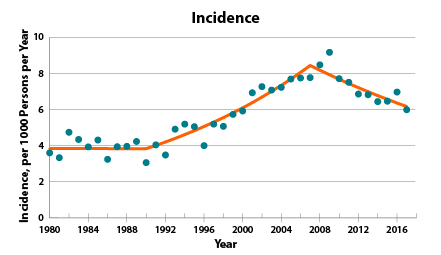After 20-Year Increase, New Diabetes Cases Decline
35% drop in new diabetes diagnoses — and no increase in total cases


After an almost 20-year increase in the prevalence and incidence of diagnosed diabetes in the United States, new cases have decreased by 35%, CDC researchers report in BMJ Open Diabetes Research & Care, from a peak of about 9.2 per 1,000 in 2009 to 6.0 per 1,000 in 2017 (figure 1). This translates to a decline of about 400,000 cases in 8 years, from 1.7 million new cases in 2009 to 1.3 million new cases in 2017.
In addition, after increasing by 4.4 percent per year from 1990 to 2009, the percentage of people living with diagnosed diabetes in the United States has remained stable at about 8.0 percent from 2009 to 2017 (figure 2). This represents the longest sustained plateau in existing cases of diagnosed diabetes and the longest decline in new cases. Similar trends were seen across all ages, racial and ethnic groups, sexes, and education levels. The data, however, do not distinguish by type of diabetes, though type 2 diabetes typically represents about 90%–95% of diabetes cases.
While the causes of the plateau and decrease remain unclear, researchers suggest they may be driven in part by increased awareness of – and emphasis on – type 2 diabetes prevention, changes in diet and physical activity, and changes in diabetes diagnostic and screening practices. Trends in population subgroups suggest the decrease in new diabetes cases may have been driven primarily by a decrease in new cases of diagnosed diabetes in non-Hispanic white adults. The plateau seen in existing cases of diabetes may be due in part to people with diabetes living longer.
Although these trends are encouraging, the overall burden of diabetes remains high and warrants continued intervention and monitoring. Today, more than 30 million Americans are living with diabetes, and 1 in 4 do not know they have it.
Learn more about diabetes in the United States and about type 2 diabetes prevention.